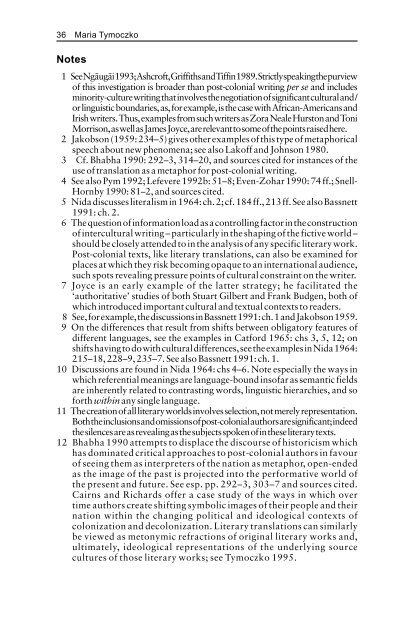post-colonial_translation
post-colonial_translation
post-colonial_translation
Create successful ePaper yourself
Turn your PDF publications into a flip-book with our unique Google optimized e-Paper software.
36 Maria Tymoczko<br />
Notes<br />
1 See Ngãugãi 1993; Ashcroft, Griffiths and Tiffin 1989. Strictly speaking the purview<br />
of this investigation is broader than <strong>post</strong>-<strong>colonial</strong> writing per se and includes<br />
minority-culture writing that involves the negotiation of significant cultural and /<br />
or linguistic boundaries, as, for example, is the case with African-Americans and<br />
Irish writers. Thus, examples from such writers as Zora Neale Hurston and Toni<br />
Morrison, as well as James Joyce, are relevant to some of the points raised here.<br />
2 Jakobson (1959: 234–5) gives other examples of this type of metaphorical<br />
speech about new phenomena; see also Lakoff and Johnson 1980.<br />
3 Cf. Bhabha 1990: 292–3, 314–20, and sources cited for instances of the<br />
use of <strong>translation</strong> as a metaphor for <strong>post</strong>-<strong>colonial</strong> writing.<br />
4 See also Pym 1992; Lefevere 1992b: 51–8; Even-Zohar 1990: 74 ff.; Snell-<br />
Hornby 1990: 81–2, and sources cited.<br />
5 Nida discusses literalism in 1964: ch. 2; cf. 184 ff., 213 ff. See also Bassnett<br />
1991: ch. 2.<br />
6 The question of information load as a controlling factor in the construction<br />
of intercultural writing – particularly in the shaping of the fictive world –<br />
should be closely attended to in the analysis of any specific literary work.<br />
Post-<strong>colonial</strong> texts, like literary <strong>translation</strong>s, can also be examined for<br />
places at which they risk becoming opaque to an international audience,<br />
such spots revealing pressure points of cultural constraint on the writer.<br />
7 Joyce is an early example of the latter strategy; he facilitated the<br />
‘authoritative’ studies of both Stuart Gilbert and Frank Budgen, both of<br />
which introduced important cultural and textual contexts to readers.<br />
8 See, for example, the discussions in Bassnett 1991: ch. 1 and Jakobson 1959.<br />
9 On the differences that result from shifts between obligatory features of<br />
different languages, see the examples in Catford 1965: chs 3, 5, 12; on<br />
shifts having to do with cultural differences, see the examples in Nida 1964:<br />
215–18, 228–9, 235–7. See also Bassnett 1991: ch. 1.<br />
10 Discussions are found in Nida 1964: chs 4–6. Note especially the ways in<br />
which referential meanings are language-bound insofar as semantic fields<br />
are inherently related to contrasting words, linguistic hierarchies, and so<br />
forth within any single language.<br />
11 The creation of all literary worlds involves selection, not merely representation.<br />
Both the inclusions and omissions of <strong>post</strong>-<strong>colonial</strong> authors are significant; indeed<br />
the silences are as revealing as the subjects spoken of in these literary texts.<br />
12 Bhabha 1990 attempts to displace the discourse of historicism which<br />
has dominated critical approaches to <strong>post</strong>-<strong>colonial</strong> authors in favour<br />
of seeing them as interpreters of the nation as metaphor, open-ended<br />
as the image of the past is projected into the performative world of<br />
the present and future. See esp. pp. 292–3, 303–7 and sources cited.<br />
Cairns and Richards offer a case study of the ways in which over<br />
time authors create shifting symbolic images of their people and their<br />
nation within the changing political and ideological contexts of<br />
colonization and decolonization. Literary <strong>translation</strong>s can similarly<br />
be viewed as metonymic refractions of original literary works and,<br />
ultimately, ideological representations of the underlying source<br />
cultures of those literary works; see Tymoczko 1995.


